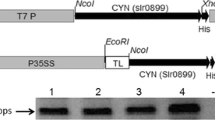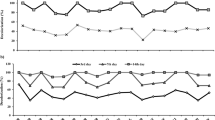Abstract
Triphenylmethane dyes are extensively utilized in textile industries, medicinal products, biological stains, and food processing industries, etc. They are generally considered as xenobiotic compounds, which are very recalcitrant to biodegradation. The widespread persistence of such compounds has generated concerns with regard to remediation of them because of their potential carcinogenicity, teratogenicity, and mutagenicity. In this study, we present a system of phytoremediation by Arabidopsis plants developed on the basis of overexpression of triphenylmethane reductase (TMR) from the Citrobacter sp. The morphology and growth of TMR transgenic Arabidopsis plants showed significantly enhanced tolerances to crystal violet (CV) and malachite green (MG). Further, HPLC and HPLC–MS analyses of samples before and after dye decolorization in culture media revealed that TMR transgenic plants exhibited strikingly higher capabilities of removing CV from their media and high efficiencies of converting CV to non-toxic leucocrystal violet (LCV). This work indicates that microbial degradative gene may be transgenically exploited in plants for bioremediation of triphenylmethane dyes in the environment.







Similar content being viewed by others
References
Aksu Z (2005) Application of biosorption for the removal of organic pollutants: a review. Process Biochem 40:997–1026
Alhassani HA, Rauf MA, Ashraf SS (2007) Efficient microbial degradation of Toluidine Blue dye by Brevibacillus sp. Dyes Pigments 75:395–400
Ayed L, Chaieb K, Cheref A, Bakhrouf A (2009) Biodegradation of triphenylmethane dye malachite green by Sphingomonas paucimobilis. World J Microbiol Biotechnol 25:705–711
Azmi W, Sani RK, Banerjee UC (1998) Biodegradation of triphenylmethane dyes. Enzyme Microb Technol 22:185–191
Banat IM, Nigam P, Singh D, Marchant R (1996) Microbial decolorization of textile-dye-containing effluents: a review. Bioresour Technol 58:217–227
Baxi NN, Shah AK (2007) The use of solid waste of a nylon-6 plant as a nutrient for bacterial decolourisation of dyes. World J Microbiol Biotechnol 23:1321–1326
Bumpus JA, Brock BJ (1988) Biodegradation of crystal violet by the white rot fungus Phanerochaete chrysosporium. Appl Environ Microbiol 54:1143–1150
Cha CJ, Doerge DR, Cerniglia CE (2001) Biotransformation of malachite green by the fungus Cunninghamella elegans. Appl Environ Microbiol 67:4358–4360
Chander M, Arora DS (2007) Evaluation of some white-rot fungi for their potential to decolourise industrial dyes. Dyes Pigments 72:192–198
Culp SJ, Beland FA (1996) Malachite green: a toxicological review. Int J Toxicol 15:219–238
Daneshvar N, Ayazloo M, Khataee AR, Pourhassan M (2007) Biological decolorization of dye solution containing malachite green by microalgae Cosmarium sp. Biores Technol 98:1176–1182
Eichlerová I, Homolka L, Nerud F (2006) Ability of industrial dyes decolorization and ligninolytic enzymes production by different Pleurotus species with special attention on Pleurotus calyptratus, strain CCBAS 461. Process Biochem 39:855–859
Gandia-Herrero F, Lorenz A, Larson T, Graham IA, Bowles DJ, Rylott EL, Bruce NC (2008) Detoxfication of the explosive 2,4,6-trinitrotoluene in Arabidopsis: discovery of bifunctional O- and C-glucosyltransferases. Plant J 56:963–974
Gregory P (1993) Dyes and dyes intermediates. In: Kroschwitz JI (ed) Encyclopedia of chemical technology. Wiley, New York, pp 544–545
Hajdukiewicz P, Svab Z, Maliga P (1994) The small versatile pPZP family of Agrobacterium binary vectors for plant transformation. Plant Mol Biol 25:989–994
Jadhav JP, Govindwar SP (2006) Biotransformation of malachite green by Saccharomyces cerevisiae MTCC 463. Yeast 23:315–323
Jang MS, Lee YM, Kim CH, Lee JH, Kang DW, Kim SJ, Lee YC (2005) Triphenylmethane reductase from Citrobacter sp. strain KCTC 18061P: purification, characterization, gene cloning, and overexpression of a functional protein in Escherichia coli. Appl Environ Microbiol 71:7955–7960
Kim MH, Kim YJ, Park HJ, Lee JS, Kwak SN, Jung WH, Lee SG, Kim D, Lee YC, Oh TK (2008) Structural insight into bioremediation of triphenylmethane dyes by Citrobacter sp. triphenylmethane reductase. J Biol Chem 283:31981–31990
Littlefield NA, Blackwell BN, Hewitt CC, Gaylor DW (1985) Chronic toxicity and carcinogenicity studies of Gentian violet in mice. Fund Appl Toxicol 5:902–912
Liu W, Chao Y, Yang X, Bao H, Qian Sh (2004) Biodecolorization of azo, anthraquinonic and triphenylmethane dyes by white-rot fungi and a laccase-secreting engineered strain. J Ind Microbiol Biotechnol 31:127–132
Macek T, Macková M, Káš J (2000) Exploitation of plants for the removal of organics in environmental remediation. Biotechnol Adv 18(1):23–34
Manal MA, El-Naggar S, El-Aasar A, Khlood IB (2005) Bioremediation of crystal violet using Hubble bioreactor packed with Pseudomonas aeruginosa. Water Res 39:5045–5054
Misra S, Gedamu L (1989) Heavy-metal tolerant transgenic Brassica napus L. and Nicotiana tabacum L. plants. Theor Appl Genet 78:161–168
Murashige SF (1962) A revised medium for rapid growth and bioassays with tobacco cultures. Plant Physiol 5:473–497
Murray EE, Lotzer J, Eberle M (1989) Codon usage in plant genes. Nucleic Acids Res 17:477–498
Nelson CR, Hites RA (1982) Aromatic amines in and near the Buffalo River. Environ Sci Technol 14:1147–1149
Novakova M, Mackova M, Chrastilova Z, Viktorova J, Szekeres M, Demnerova K, Macek T (2009) Cloning of the bacterial bphC gene into Nicotiana tabacum to improve the efficiency of PCB phytoremediation. Biotechnol Bioeng 102:29–37
Novotny C, Rawal B, Bhatt M, Patel M, Sasek V, Molitoris HP (2001) Capacity of Irpex lacteus and Pleurotus ostreatus for decolorization of chemically different dyes. J Biotechnol 89:113–122
Peng RH, Xiong AS, Yao QH (2006) A direct and efficient PAGE-mediated overlap extension PCR method for gene multiple-site mutagenesis. Appl Microbiol Biotechnol 73:234–240
Sambrook J, Fritsch EF, Maniatis T (1989) Molecular cloning: a laboratory manual. Cold Spring Harbor Laboratory Press, Cold Spring Harbor, pp 1.53–1.70
Sani RK, Banerjee UC (1999) Decolorization of triphenylmethane dyes and textile and dye-stuff effluent by Kurthia sp. Enz Microbiol Technol 24:433–437
Sharma DK, Saini HS, Singh M, Chimni SS, Chadha BS (2004) Biotreatment of simulated textile dye effluent containing malachite green by an up-flow immobilized cell bioreactor. World J Microbiol Biotechnol 20:431–434
Tekere M, Mswaka AY, Zvauya R, Read JS (2001) Growth, dye degradation and ligninolytic activity studies on Zimbabwean white rot fungi. Enz Microbiol Technol 28:420–426
Xiong AS, Yao QH, Peng RH, Duan H, Li X, Fan HQ, Cheng ZM, Li Y (2006) PCR-based accurate synthesis of long DNA sequences. Nat Protoc 1:791–797
Zhang X, Henriques R, Lin SS, Niu QW, Chua NH (2006) Agrobacterium-mediated transformation of Arabidopsis thaliana using the floral dip method. Nat Protoc 1:641–646
Zille A, Górnacka B, Rehorek A, Cavaco-Paulo A (2005) Degradation of azo dyes by Trametes villosa laccase over long periods of oxidative conditions. Appl Environ Microbiol 71:6711–6718
Acknowledgments
The authors thank Professor Nigel Halford, Rothamsted Research, United Kingdom, for critical reading of the manuscript. The research was supported by the National Natural Science Foundation of China (31071486), The Key Project Fund of the Shanghai Municipal Committee of Agriculture (No. 2009-6-4 and No. 2011-1-8), and International Scientific and Technological Cooperation (2010DFA62320).
Author information
Authors and Affiliations
Corresponding authors
Additional information
Xiao-Yan Fu and Wei Zhao contributed equally to this article.
Electronic supplementary material
Below is the link to the electronic supplementary material.
ESM 1
(DOC 1637 kb)
Rights and permissions
About this article
Cite this article
Fu, XY., Zhao, W., Xiong, AS. et al. Phytoremediation of triphenylmethane dyes by overexpressing a Citrobacter sp. triphenylmethane reductase in transgenic Arabidopsis . Appl Microbiol Biotechnol 97, 1799–1806 (2013). https://doi.org/10.1007/s00253-012-4106-0
Received:
Revised:
Accepted:
Published:
Issue Date:
DOI: https://doi.org/10.1007/s00253-012-4106-0




